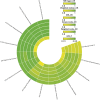Exploring the Bidirectional Effects of Gut Microbiota and Short-Chain Fatty Acids on Urticaria Subtypes Through Mendelian Randomization and Mediation Analysis
- PMID: 39155883
- PMCID: PMC11328851
- DOI: 10.2147/CCID.S474422
Exploring the Bidirectional Effects of Gut Microbiota and Short-Chain Fatty Acids on Urticaria Subtypes Through Mendelian Randomization and Mediation Analysis
Abstract
Background: Emerging evidence links gut microbiota and their by-products, notably short-chain fatty acids (SCFAs), to urticaria. This study employs multiple Mendelian Randomization (MR) analyses to unravel the complex interactions among gut microbiota, SCFAs, and different subtypes of urticaria, aiming to elucidate the underlying mechanisms and enhance future clinical research.
Methods: We analyzed published genome-wide association study (GWAS) summary statistics to identify associations between gut microbiota and three common subtypes of urticaria: spontaneous, dermatographic, and temperature-triggered. Initial two-sample and reverse MR analyses explored the causality in these relationships. Subsequent multivariate MR analyses investigated the role of SCFAs in modulating these interactions, with multiple sensitivity analyses to ensure robustness.
Findings: Specific taxa were differently associated with various urticaria subtypes. From microbiota to urticaria: one taxon was negatively associated with dermatographic urticaria; seven taxa were negatively associated and four positively associated with temperature-triggered urticaria; four taxa were negatively associated and six positively associated with spontaneous urticaria. Conversely, from urticaria to microbiota: five taxa were negatively associated with dermatographic urticaria; four were negatively and two positively associated with temperature-triggered urticaria; and two were negatively associated with spontaneous urticaria. These associations were observed at a nominal significance level (P < 0.05). After applying Bonferroni correction for multiple testing, these associations did not reach statistical significance. The observed trends, however, provide insights into potential microbiota-urticaria interactions. Multivariate MR analyses elucidated the role of SCFAs, particularly acetate, which plays a crucial role in modulating immune response. Adjusting for acetate revealed direct effects of Actinobacteria, Bifidobacteriales, and Bifidobacteriaceae on spontaneous urticaria, with corresponding mediation effects of -22%, -24.9%, and -24.9% respectively. Similarly, adjustments for Alcaligenaceae and Betaproteobacteria indicated significant negative effects of acetate on dermatographic and spontaneous urticaria, with mediation effects of -21.7% and -23.7%, respectively.
Conclusion: This study confirms the interconnected roles of gut microbiota, SCFAs, and urticaria. It highlights SCFAs' potential mediating role in influencing urticaria through microbiota, providing insights for future therapeutic strategies.
Keywords: Mendelian randomization; gut microbiota; gut-skin axis; short-chain fatty acids; urticaria.
© 2024 Xiao et al.
Conflict of interest statement
The authors report no conflicts of interest in this work.
Figures




Similar articles
-
Genetic liability of gut microbiota for idiopathic pulmonary fibrosis and lung function: a two-sample Mendelian randomization study.Front Cell Infect Microbiol. 2024 May 22;14:1348685. doi: 10.3389/fcimb.2024.1348685. eCollection 2024. Front Cell Infect Microbiol. 2024. PMID: 38841114 Free PMC article.
-
Effect of the gut microbiome, plasma metabolome, peripheral cells, and inflammatory cytokines on obesity: a bidirectional two-sample Mendelian randomization study and mediation analysis.Front Immunol. 2024 Mar 15;15:1348347. doi: 10.3389/fimmu.2024.1348347. eCollection 2024. Front Immunol. 2024. PMID: 38558794 Free PMC article.
-
Potential mechanisms of gut microbiota influence on different types of vertigo: a bidirectional Mendelian randomization and mediation analysis.BMC Neurol. 2024 Aug 27;24(1):297. doi: 10.1186/s12883-024-03805-x. BMC Neurol. 2024. PMID: 39192194 Free PMC article.
-
Causal relationship between gut microbiota and urticaria: a bidirectional two-sample mendelian randomization study.Front Microbiol. 2023 Jun 22;14:1189484. doi: 10.3389/fmicb.2023.1189484. eCollection 2023. Front Microbiol. 2023. PMID: 37426010 Free PMC article.
-
Causal relationship between gut microbiota and polycystic ovary syndrome: a literature review and Mendelian randomization study.Front Endocrinol (Lausanne). 2024 Feb 1;15:1280983. doi: 10.3389/fendo.2024.1280983. eCollection 2024. Front Endocrinol (Lausanne). 2024. PMID: 38362275 Free PMC article. Review.
References
Grants and funding
LinkOut - more resources
Full Text Sources

